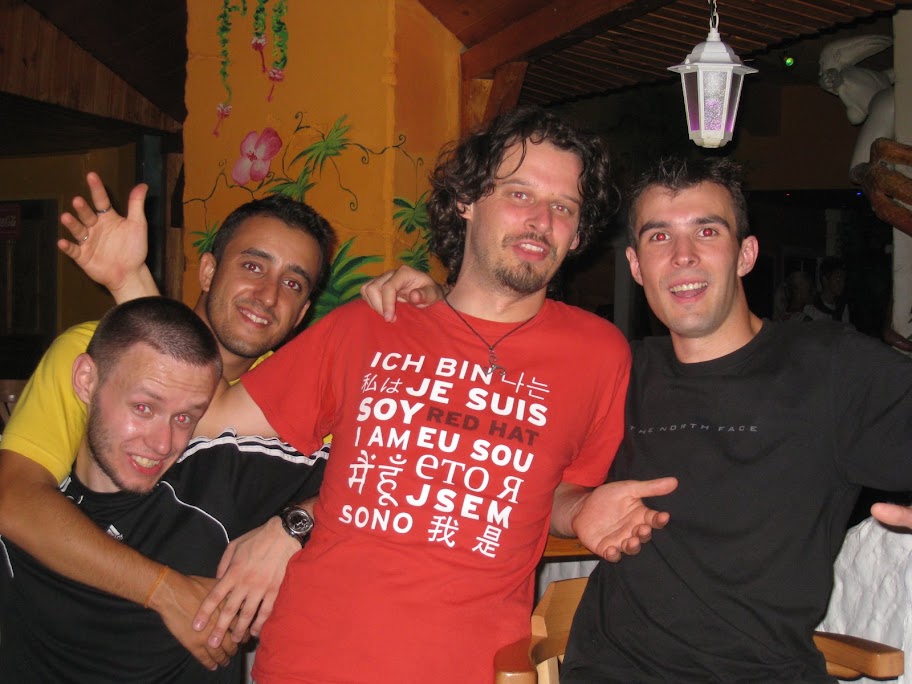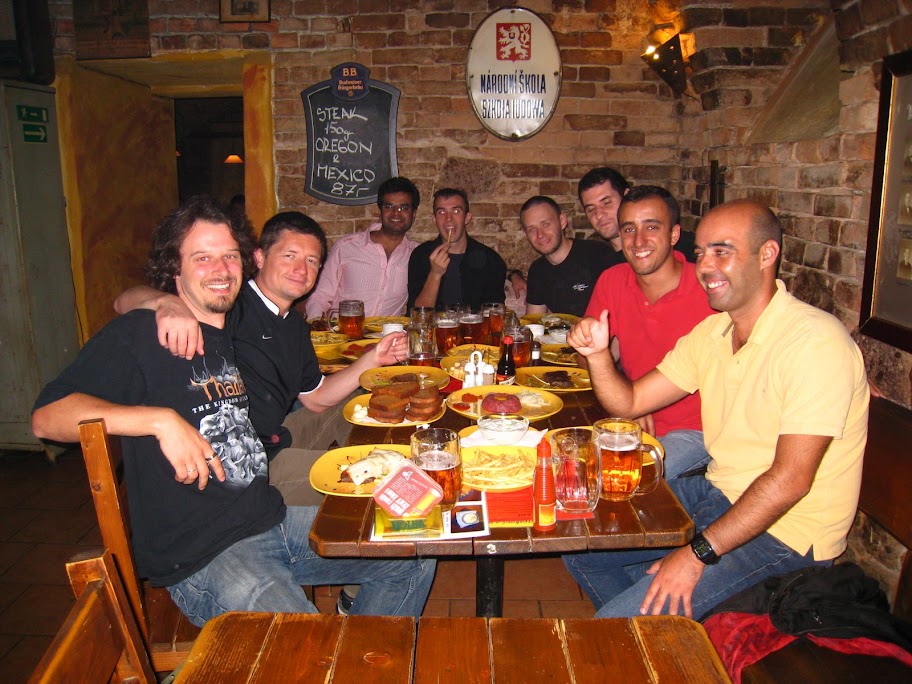It happened. In 1.X branch we dropped console for some reasons (many discussion, outcome the same). During last MMS chat Oleg spoke words we believed noone will witnes him say: "Maybe its time for..."
Well thats the background. To make it short. We would like to announce that MMS 2.X will have management console. How it will look like? It all depends on feedback we get from users. We have general idea, but feedback and ideas are mostly welcome.
Design Wiki can be found here , public thread can be found here.
Wednesday, September 23, 2009
Sunday, September 13, 2009
MMS - Control Protocols
In mobicents projects we have different EE:
EE is driven by some sort of protocol chosen by development team - which has complete freedom to choose one protocol over another, restricted only by project requirements. In case of media server it is not that easy. Over time different "parties" created different control protocols for media server (media gateway).
For instance with CISCO equipment media server is controled with MGCP, in IMS environment media server is controled with H.248, in WWW it can be controled with RTSP, etc, etc.
In Mobicents Media Server 1.x.y we support only MGCP (aside of local MSC API), however we felt that this is not enough to meet demand from partners and community (more on this here).
So for MMS 2.x we have more in plans:
Here we go.
As mentioned above media servers follow certain model of operation. See image below:
Basic inforamtion:
MSML is also RTP service oriented. Protocol does not define endpoint types as MGCP does for instance. It only defines actions that need to be undertaken to produce stream/interaction with user stream.
As protocol MSML is designed to be extensible, just as Diameter does. Functional elements are grouped into package. Each package defines set of primitives which affect Media Server. Prmitives are tags and their parameters which are intepreted by Media Server controler.
MSML allows new packages to be defined along ability to extend already defined. This is how whole language structure is defined. Definition from RFC are grouped as follows:
- SLEE
- MSS
- . . . (maybe more)
EE is driven by some sort of protocol chosen by development team - which has complete freedom to choose one protocol over another, restricted only by project requirements. In case of media server it is not that easy. Over time different "parties" created different control protocols for media server (media gateway).
For instance with CISCO equipment media server is controled with MGCP, in IMS environment media server is controled with H.248, in WWW it can be controled with RTSP, etc, etc.
In Mobicents Media Server 1.x.y we support only MGCP (aside of local MSC API), however we felt that this is not enough to meet demand from partners and community (more on this here).
So for MMS 2.x we have more in plans:
- RTSP
- H.248
- MSML
- VXML
Here we go.
Media Server Operation Model
As mentioned above media servers follow certain model of operation. See image below:
Media Server estabilishes only RTP stream exchanged between UAs. To setup streaming application makes use of some dedicated control protocol. Dedicated controler on Media Server side converts control protocol reqeusts into physical setup of underlying resources(generators,detectors, codecs, etc....). This happens regardles of signaling protocol used(on image it is SIP, but in reality it could be any suitable for application).
MSML: Media Server Markup Language
Basic inforamtion:
- XML Based
- It is independent of transport protocol ( SIP, HTTP, IP, ...)
- Follows simple request/response model
- Supports transactions
- Supports semi-recovery from errors
- Requires resource reservation
- RTP service oriented
MSML is also RTP service oriented. Protocol does not define endpoint types as MGCP does for instance. It only defines actions that need to be undertaken to produce stream/interaction with user stream.
As protocol MSML is designed to be extensible, just as Diameter does. Functional elements are grouped into package. Each package defines set of primitives which affect Media Server. Prmitives are tags and their parameters which are intepreted by Media Server controler.
MSML allows new packages to be defined along ability to extend already defined. This is how whole language structure is defined. Definition from RFC are grouped as follows:
- Core
- Dialog-Core
- Conf-Core
- Audit-Core
- Dialog-Base
- Dialog-Transform
- Dialog-Speech
- .....
MSML: Base abstraction
Base MSML abstraction defines functional elements which are aligned as in image below:- conn - connection is logical unit which termiantes all RTP sessions from one UA
- operator - logical unit representing DSP
- dialog - set of automated actions like: play, DTMF generator/detector, etc...
- conf - logical unit which mixes streams
MSML: Protocol use example
Below is use case of MSML encapsulated in SIP protocol.
MSML used inside SIP requires usually dialog to be established between application server and media server. MSML Requests/Answers are embeded in SIP INFO/INFO OK message.
In image above there is only one UA, which awaits video to be played. However for different number of UAS scheme is similar - only difference is dialog time when dialog is estabilished between app server and media server.
In example scenario app server asks Media Server to play announcement like (this is MSML Dialog): "Press one to play movie XXXXX, Press two to play movie xXXYYx" and detect DTMFs. Once UA sends DTMF, Media Server sends DTMF embeded in SIP INFO back to application server and indication that MSML Dialog has ended. Application server decodes INFO, picks file to be streamed back to UA and starts new MSML Dialog: "Play Movie Dialog".
Other protocols will follow in subsequent posts.
Saturday, September 5, 2009
Slee 1.1 Classloader demystified!
Here we go.
During our dev struggle to get v2 of Mobicents JSLEE container operational we encountered quite big problem: Class Loading scheme.
Usually class loaders are organized in classic tree structure:
Moreover it is not possible to maintain integrity of classes loaded - consider situation:
Now regarding Mobicents JSLEE v1. JSLEE Specs did not define any way of providing dependency classes. To resolve this problem we altered a bit DU structure, each DU jar could have "library" dir with dependencies for particular DU. This proved to be enough to solve dependencies, however all above problems still apply.
Obviously JSR240 specs lead got a notion that specs lack something valuable here and in 1.1 it has been improved.
In 1.1 container "library" component has been introduced. It is not a functional component/jar - not in terms of slee, like SbbComponent or ProfileCompoment. Its only purpose is to provide standarised and versioned way to provide classes to Slee components. So no more DU/library!!
Now about classloaders. In SLEE v1.1 model has changed as well. Its a bit tricky. Consider classic model - tree, where each classloader with one parent. This is not sufficient for SLEE v1.1. New model allows multiple parent for each leaf to reflect components relation.
Classloaders are defined per component - that is not jar, but actual identifiable component(which has ComopnentID). Component class loader loads all classes from component jar "and" all classes from referenced components.
Consider case of jar file which contains definition of Sbb1, Sbb2 and Sbb3 - all sbb classes are in jar.
So:

During our dev struggle to get v2 of Mobicents JSLEE container operational we encountered quite big problem: Class Loading scheme.
Usually class loaders are organized in classic tree structure:
- one root
- each leaf can have only one parent
- each leaf can be a root of a subtree
Moreover it is not possible to maintain integrity of classes loaded - consider situation:
- DU1 has service using lib.jar
- DU2 also has service using lib.jar
- order of deply is: DU1,DU2
- when DU2 is deployed, classloader finds lib.jar classes and does not load them
- DU1 and DU2 services kick in, instances of lib.jar classes are created (from DU1 definition)
- now DU1 is undeployed
- error on class casting - vague information: can not cast XXYX.class to XXYX.class
Now regarding Mobicents JSLEE v1. JSLEE Specs did not define any way of providing dependency classes. To resolve this problem we altered a bit DU structure, each DU jar could have "library" dir with dependencies for particular DU. This proved to be enough to solve dependencies, however all above problems still apply.
Obviously JSR240 specs lead got a notion that specs lack something valuable here and in 1.1 it has been improved.
In 1.1 container "library" component has been introduced. It is not a functional component/jar - not in terms of slee, like SbbComponent or ProfileCompoment. Its only purpose is to provide standarised and versioned way to provide classes to Slee components. So no more DU/library!!
Now about classloaders. In SLEE v1.1 model has changed as well. Its a bit tricky. Consider classic model - tree, where each classloader with one parent. This is not sufficient for SLEE v1.1. New model allows multiple parent for each leaf to reflect components relation.
Classloaders are defined per component - that is not jar, but actual identifiable component(which has ComopnentID). Component class loader loads all classes from component jar "and" all classes from referenced components.
Consider case of jar file which contains definition of Sbb1, Sbb2 and Sbb3 - all sbb classes are in jar.
So:
- three classloaders - Sbb1,Sbb2, Sbb3 - each "has" classes from jar
- SbbX classloader has access to all referenced component classloaders

Etykiety:
mobicents slee jsr240
Friday, September 4, 2009
Mobicents Diameter - reaches 1.0.2.GA !!!
Yes, thats true. Me and Alex managed to contribute enough time(even though he was sick and I was busy with personal erands) to make another diameter release. Still follow up will contain standalone documentation (yupieeee!!) with examples of configuration and setup.
More about release here.
Would like to make reminder about VM image we created with openIMS predeployed to make users life a bit easier, atleast for testing:
Thats it for today. Cheers
More about release here.
Would like to make reminder about VM image we created with openIMS predeployed to make users life a bit easier, atleast for testing:
Thats it for today. Cheers
Etykiety:
mobicents diameter IMS
3rd Annual Mobicents Metting: Brno 2009
This august was quiet a big deal, Mobicents Team met in Brno office which was kind enough(or else) to host annual meeting. Almost all of us made it to office without any incident, however we still missed three team members which did not make it.
As usual it was tons of work and work. Since last year mobicents grew a lot (maybe not a good estimate but svn code and commits have been more than doubled, with team not expanding at all) so we had a lot of topics to go through. During las year three of our project reached GA status:
Thats how we spent our time in the office - except me and Amit killing each other bond style(we were supposed to go for paintball, but eventually it has been canceled).
My main project(aside Diameter and JSLEE) is Media Server for the time beeing. Thats the one me and my co-mates were supposed to cover during this meeting.
However one of our MMS team member did not make it to Brno me and Amit were supposed to cover his topics(MMS Architecture & SS7 introduction) - in practice presentations we created were covered by Amit.
Topics that left for me were
Aside my HA session we had one covered by Jean D and Vladimir R. Outcome? To make it short:
What about fun part?
It was not bad at all, even though academic year has not started:
Before plunging into disco:
 Get up early, go to work, eat late and party till morning. Here we are at eating part, good food, perfect beer, even portugal folks prefered it over wine:
Get up early, go to work, eat late and party till morning. Here we are at eating part, good food, perfect beer, even portugal folks prefered it over wine:

And here we give a go to extreme sports part, carts made it a day, except few of us getting burns blisters from engine, it was worth chasing other team members around track:
As usual it was tons of work and work. Since last year mobicents grew a lot (maybe not a good estimate but svn code and commits have been more than doubled, with team not expanding at all) so we had a lot of topics to go through. During las year three of our project reached GA status:
- Sip Servlets
- Media Server
- Diameter
- Media Server
- JAIN Slee
- JSR 289 certification (Sip Servlets 1.1)
- JSR 240 certification( JSLEE 1.1, achieved by container v2.0.0.B1)
- Media Server modular architecture
- Diameter GA
- Seam Telco Framework reaching stability
- SS7 world mobicents role in IMS cloud
- JSLEE 1.1 container architecture
- HA
- Media Server architecture
Thats how we spent our time in the office - except me and Amit killing each other bond style(we were supposed to go for paintball, but eventually it has been canceled).
My main project(aside Diameter and JSLEE) is Media Server for the time beeing. Thats the one me and my co-mates were supposed to cover during this meeting.
However one of our MMS team member did not make it to Brno me and Amit were supposed to cover his topics(MMS Architecture & SS7 introduction) - in practice presentations we created were covered by Amit.
Topics that left for me were
- Base HA framework - how to achieve HA for non cache replicated resources
- MMS Control protocols(which I did not present, see my other posts)
Aside my HA session we had one covered by Jean D and Vladimir R. Outcome? To make it short:
- improve JSIP stack
- make JSIP stack modular so it supports replication of data
- finalize LB strategy
- cooperate on Fault Tolertant Framework
What about fun part?
It was not bad at all, even though academic year has not started:
Before plunging into disco:
 Get up early, go to work, eat late and party till morning. Here we are at eating part, good food, perfect beer, even portugal folks prefered it over wine:
Get up early, go to work, eat late and party till morning. Here we are at eating part, good food, perfect beer, even portugal folks prefered it over wine:
And here we give a go to extreme sports part, carts made it a day, except few of us getting burns blisters from engine, it was worth chasing other team members around track:

Etykiety:
mobicents meeting brno 2009
Subscribe to:
Posts (Atom)


